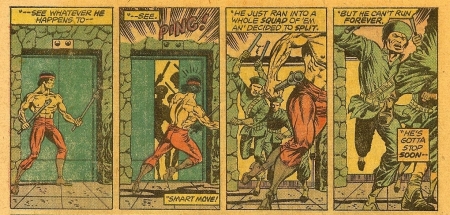
Shang Chi, Master of Kung Fu – four panel rotating zoom sequence from MOKF No. 49 – art by Paul Gulacy
This is the third, and for now final, in a series of blog articles about the comic book Master of Kung Fu – MOKF – and my favorite issues of it, written by Doug Moench and drawn by Paul Gulacy. I recommend you start reading with part 1, then part 2, then read this piece below.
– – – – –
This third piece will focus on what I think is really Gulacy and Moench’s crowning achievement: a six-issue story arc beginning with MOKF No. 45 – October 1976 through MOKF No. 50 – March 1977.
It’s a cinematic, sweeping arc that reads a bit like a James Bond movie. What distinguishes it from pretty much any comic book that I’ve ever read, is that Moench has written each issue in the voice of a specific character. Usually MOKF featured a sort of internal voiceover narration – the thoughts of Shang-Chi. For these six issues, the narration shifts from character to character. Sometimes internal, sometimes spoken.
These six character voices are often clever and somewhat revealing about each narrator. (more…)











![mom_1996[1]](https://theperiodicfable.files.wordpress.com/2011/08/mom_19961.jpg?w=450)